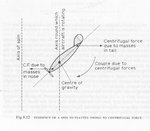He-162
...The call for a Volksjager(people's fighter) is an astonishing late- war accomplishment that went from drawing board to flight in only three months. This very hurried project (code-named "Salamander") managed to produce the Heinkel 162, "unique in the history of aviation as the only aircraft in which development, pre-production prototypes and main production lines were started almost simultaneously and proceeded in parallel." Curious in the design is the location of the jet engine, mounted on top of the fuselage directly above and behind the cockpit; this motivated the installation of a simple ejection seat, reflecting that the pilots were more highly valued than the aircraft itself.
The aircraft itself was very effective as a fighter interceptor, equalling the Me-262. In some ways it was superior: "The BMW engine proved to be far less sensitive to throttle movments than those of the Me 262, though still prone to flameouts. This allowed the He 162 to be flown up to the limits of the pilot's confidence in the aircraft, unlike the Me 262 whose engines restricted much in the way of maneuvers." It was very fast and well armed. However, it had a problem of having a very short flight time of 30 minutes, and many operational losses were due to running out of fuel.
Despite its rapid development and excellent qualities, it was another case of too little too late for the Luftwaffe. The production program was planned to put out 4,000 aircraft per month, but only a few hundred were in fact produced because of the success of the Allied bombing campaign. Although a very few He-162s did see action over Germany in April 1944, the fighter essentially had no impact on the war.
il2guide
Galland didn't share in the above regard for the viability of the 162 as an interceptor.
Regards,
Magnon
...The call for a Volksjager(people's fighter) is an astonishing late- war accomplishment that went from drawing board to flight in only three months. This very hurried project (code-named "Salamander") managed to produce the Heinkel 162, "unique in the history of aviation as the only aircraft in which development, pre-production prototypes and main production lines were started almost simultaneously and proceeded in parallel." Curious in the design is the location of the jet engine, mounted on top of the fuselage directly above and behind the cockpit; this motivated the installation of a simple ejection seat, reflecting that the pilots were more highly valued than the aircraft itself.
The aircraft itself was very effective as a fighter interceptor, equalling the Me-262. In some ways it was superior: "The BMW engine proved to be far less sensitive to throttle movments than those of the Me 262, though still prone to flameouts. This allowed the He 162 to be flown up to the limits of the pilot's confidence in the aircraft, unlike the Me 262 whose engines restricted much in the way of maneuvers." It was very fast and well armed. However, it had a problem of having a very short flight time of 30 minutes, and many operational losses were due to running out of fuel.
Despite its rapid development and excellent qualities, it was another case of too little too late for the Luftwaffe. The production program was planned to put out 4,000 aircraft per month, but only a few hundred were in fact produced because of the success of the Allied bombing campaign. Although a very few He-162s did see action over Germany in April 1944, the fighter essentially had no impact on the war.
il2guide
Galland didn't share in the above regard for the viability of the 162 as an interceptor.
Regards,
Magnon



